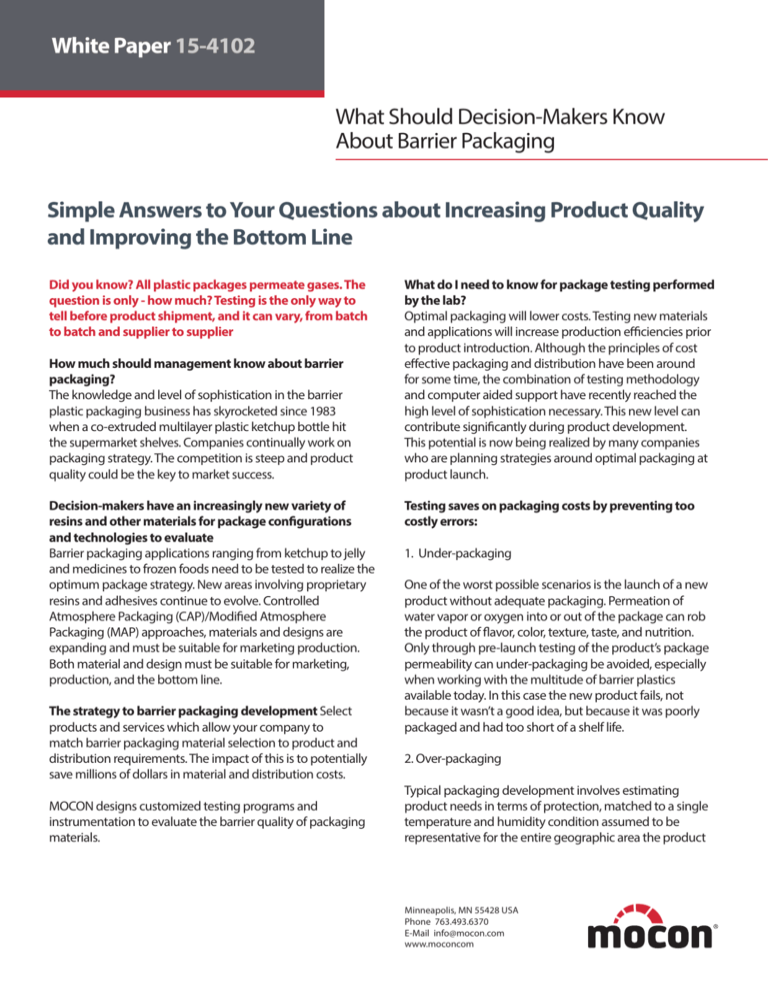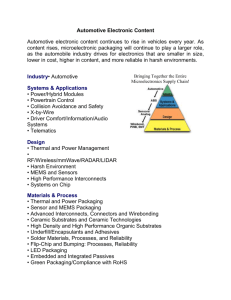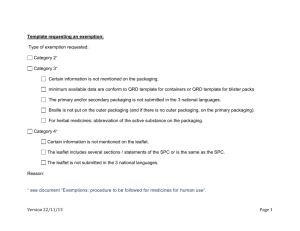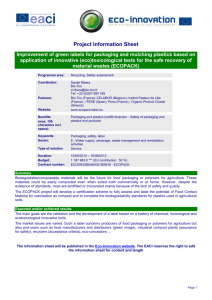
White Paper 15-4102
What Should Decision-Makers Know
About Barrier Packaging
Simple Answers to Your Questions about Increasing Product Quality
and Improving the Bottom Line
Did you know? All plastic packages permeate gases. The
question is only - how much? Testing is the only way to
tell before product shipment, and it can vary, from batch
to batch and supplier to supplier
How much should management know about barrier
packaging?
The knowledge and level of sophistication in the barrier
plastic packaging business has skyrocketed since 1983
when a co-extruded multilayer plastic ketchup bottle hit
the supermarket shelves. Companies continually work on
packaging strategy. The competition is steep and product
quality could be the key to market success.
Decision-makers have an increasingly new variety of
resins and other materials for package configurations
and technologies to evaluate
Barrier packaging applications ranging from ketchup to jelly
and medicines to frozen foods need to be tested to realize the
optimum package strategy. New areas involving proprietary
resins and adhesives continue to evolve. Controlled
Atmosphere Packaging (CAP)/Modified Atmosphere
Packaging (MAP) approaches, materials and designs are
expanding and must be suitable for marketing production.
Both material and design must be suitable for marketing,
production, and the bottom line.
The strategy to barrier packaging development Select
products and services which allow your company to
match barrier packaging material selection to product and
distribution requirements. The impact of this is to potentially
save millions of dollars in material and distribution costs.
MOCON designs customized testing programs and
instrumentation to evaluate the barrier quality of packaging
materials.
What do I need to know for package testing performed
by the lab?
Optimal packaging will lower costs. Testing new materials
and applications will increase production efficiencies prior
to product introduction. Although the principles of cost
effective packaging and distribution have been around
for some time, the combination of testing methodology
and computer aided support have recently reached the
high level of sophistication necessary. This new level can
contribute significantly during product development.
This potential is now being realized by many companies
who are planning strategies around optimal packaging at
product launch.
Testing saves on packaging costs by preventing too
costly errors:
1. Under-packaging
One of the worst possible scenarios is the launch of a new
product without adequate packaging. Permeation of
water vapor or oxygen into or out of the package can rob
the product of flavor, color, texture, taste, and nutrition.
Only through pre-launch testing of the product’s package
permeability can under-packaging be avoided, especially
when working with the multitude of barrier plastics
available today. In this case the new product fails, not
because it wasn’t a good idea, but because it was poorly
packaged and had too short of a shelf life.
2. Over-packaging
Typical packaging development involves estimating
product needs in terms of protection, matched to a single
temperature and humidity condition assumed to be
representative for the entire geographic area the product
Minneapolis, MN 55428 USA
Phone 763.493.6370
E-Mail info@mocon.com
www.moconcom
Application Note 15-4102
will be sold, and then choosing materials expected to last for that
system. Over packaging is usually done to avoid the potential risks
of under packaging. Then as time passes cost reduction programs
are implemented to bring costs down. If the proper testing
program has been implemented pre-launch, millions of dollars
could have been saved in wasted over packaging. And, once the
product is a success, it’s often impossible to change anything
connected with the package design for fear of losing market
share.
It is critically important for both
the suppliers and end-users
of plastic barrier packages to
communicate quantitatively
about other materials. Testing is
the key to that communication
Cost reductions example #1
Cost reductions are indications of the overspending that has
occurred. For example, many companies have reduced packaging
expenditures in excess of $1 million per year through redesign
of the package. However, a pre-determined approach that takes
into account actual product and distribution requirements and
quantitatively matches of them to packaging material properties
can allow for optimized packaging at the outset.
Please refer to Figure 1, the gray bar represents the original
packaging costs and subsequent cost reduced packages. The red
bar shows consistency for an optimal package. The savings is the
difference in cost of each package times the number of years the
package was used. The economic implications can be significant.
Standard
Package
% Relative Cost of Materials
100
0
Optimal
Package
Original
Packaging
1st Cost
Reduction
Time
Figure 1.
2nd Cost
Reduction
3rd Cost
Reduction
Save development time
1. Identify product requirements
We work with your people to understand how to develop a
package specification. The maximum amount of allowable
product degradation must be specified.
2. Measure package protection
Next, protection available from various packaging
materials is determined with lab instrumentation or testing
services.
3. Determine optimal system
The product requirements and package protection are
then matched to either determine the shelf life obtainable
in a specific material, or to determine which material will
supply a specified shelf life.
4. Fast results
Test results on equipment is available in a matter of hours
as compared to storage studies which usually take 4
to 6 months. In addition, storage studies are normally
discontinued at a preset time and any protection beyond
that time is not evaluated.
We can improve new material evaluation
With so many new barrier packaging materials and resins
being made available, it is often difficult to compare
permeation data as derived from material suppliers’
data sheets. With the proper amount of foresight, a
comprehensive materials testing program can be
implemented which will enable management to properly
select the best barrier material for a particular application.
And, there is a great comfort in knowing that the decision
is based on the actual test data and not on performance
claims from outside the company.
Ensure finished package integrity example #2
Full package testing allows determination of the affects of
the plant operations on your package. For example, the
glassines used for cereal packaging have excellent barrier
properties in flat sheet. The formation of the package,
however, tends to crack the wax coating and decrease this
barrier. Therefore, the expected protection is not found
in the marketplace. Many cereal products have shifted to
structures that are less prone to this change. Testing can
determine this prior to market entry. Permeation testing
is performed on flat sheet and/or full packages after
formation. The difference in permeation values shows the
machining effect on the barrier material.
Application Note 15-4102
Expand into selective markets example #3
Packaging performance can be studied for different cities and
for different times of year. Figure 2 illustrates differences in
shelf life for the same product and package in various cities. If
you can speed your distribution through Miami, for example,
you can reduce your packaging costs countrywide and realize
real savings. It is costly to always package for the worst market
area and to assume the distribution must be the same for all
market areas.
Another option is to use data to identify materials which
would be applicable for say Miami, if you wish to alter the
packaging for the critical markets. The potential of this
approach is also to save costs for the bulk of the US or
Worldwide markets. The bottom line is that your packaging
can reflect real, rather than theorized, requirements and meet
those needs for the most cost-effective packaging.
Figure 2. Copyright by Kenneth S. Marsh & Associates. Used with
permission.
Finally, we can help to ...
• Decrease packaging costs
• Shorten development time
• Improve new material evaluation
• Measure finished package performance
• Allow expansion into selective markets
We offer alternatives to traditional approaches thereby
allowing optimization of the costs of the package/distribution
system. By modifying either distribution in critical markets,
packaging materials in critical vs. non-critical markets, or both,
large savings are possible.
MOCON has a full line of barrier testing instrumentation for
all levels of plastic packaging from resin development to
films to finished packages. MOCON barrier materials testing
instruments and consulting services can provide you with
the most cost-effective package for the unique needs of your
specific product.
Minneapolis, MN 55428 USA
Phone 763.493.6370
E-Mail info@mocon.com
www.moconcom
Copyright © 2014, MOCON, Inc. All rights reserved.
MOCON, AQUATRAN and PERMATRAN-W are registered trademarks of MOCON, Inc.







